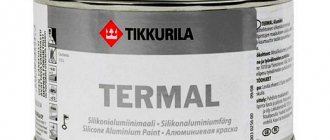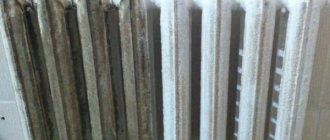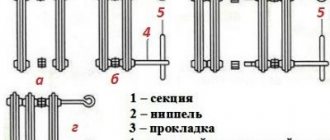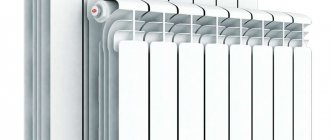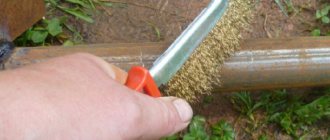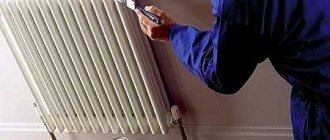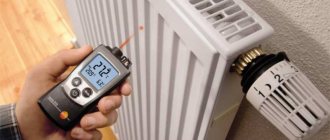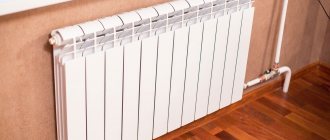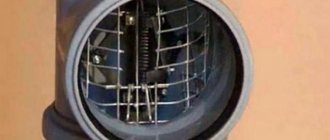Preparing the radiator for painting
Before you start applying paint to the heating radiator, its surface must first be prepared for painting.
The preparation process may take longer than the painting itself, but will result in a better quality paint job. Old, cracked paint and rust must be removed using a wire brush, coarse sandpaper or special solutions that soften the paint and weaken its connection to the surface of the battery. Removing old paint and rust creates a rougher surface that allows the new paint to bond better to the radiator surface.
Brushing disc brush.
Using manual mechanical cleaning tools (wire brush, sandpaper) is a long and labor-intensive process that can be sped up using a power tool. The most suitable tool in this case is a grinder with a special grinding wheel or brush. However, when using an angle grinder, you need to know when to stop and not overdo it, because
high rotation speeds allow you to quickly remove paint and rust, after which you can inadvertently begin to erase the surface of the radiator itself (if you use a cleaning wheel), which of course should not be done
The use of solvents to remove paint (so-called strippers) is the fastest way to remove old paint, but at the same time the most “harmful”.
Important! Special solvents for paint removal pose a danger to human health. Therefore, when using them, good ventilation of the room and the use of personal protective equipment (goggles, gloves, respirator or mask) are mandatory. Acrylic enamel “Rainbow” for metal and heating radiators
Acrylic enamel “Rainbow” for metal and heating radiators.
There are 2 main types of washes:
- In liquid form;
- In aerosol form.
Liquid-based removers are applied with a brush (this is their main drawback: the difficulty of applying to the internal parts of the radiator), after 10-15 minutes. the paint will soften and can be removed with a spatula or wire brush. After this, use a sponge to wash the surface to be treated with soap and water.
The solution with liquid is in a high-strength container, so it is prohibited to pour it into another container. A 6-section cast iron radiator requires about 0.5 liters. washes.
An aerosol-based cleaner is sprayed onto the surface of the radiator from a can. The advantage of the aerosol is that it can be applied to the most inaccessible parts of the heating device. As a rule, aerosol removers are universal means and are suitable for removing any type of paint for a heating radiator, regardless of the basis on which they are made.
Before spraying, you must carefully cover all nearby furnishings, the floor and the wall behind the radiator. 15-40 minutes after applying the aerosol, the paint softens and is easy to remove with any available means (spatula, metal brush, etc.).
Waterproof enamel for radiators VGT super white. Weight: 0.5 kg, enough for 5 m².
Advice! As an anti-corrosion agent, you can additionally use corrosion inhibitors, which slow down or completely stop the corrosion process of metal products. High-quality inhibitors are able to penetrate the radiator metal even through thick layers of corrosion. This allows you to reach the most remote areas of the heating device (blockages in the connections).
Removing paint by heating it
During heat treatment of the radiator, harmful substances are released, so for work you will need personal protective equipment (respirator, rubber gloves, goggles), in addition to this, it is better to carry out work outside, at least in a well-ventilated area.
To work, you will need a hair dryer, a wire brush and a spatula. Using a construction hair dryer, the surface of the radiator is heated until the old paint begins to swell. At this point you can begin to remove it. The disadvantages of the thermal method of removing paint include the fact that high temperatures can damage the intersection gaskets of the radiator.
Aerosol for radiators. White semi-gloss. 1 cylinder for 8 sections. With smell. Drying time 2 hours.
Preparing for cleaning
It is preferable to carry out work to remove outdated enamel immediately before starting renovation work indoors, when preliminary preparatory work on the floors and walls has already been carried out. To carry out this removal procedure, you will need a spatula made of metal, a hard brush, and a simple rag.
Important! If cleaning of radiators is carried out after completion of repair work indoors, then in this case, the workplace where paint is removed must be properly insulated. To do this, you can use high-density paper or film.
It is preferable to remove paint and varnish material from removed radiators outdoors. However, this is not always possible. Regardless of the chosen cleaning method, mechanical or chemical, during work it is necessary to use rubberized or thick fabric gloves, a respirator, and safety glasses.
Enamel removal work must be carried out with the heating system turned off. Mechanical cleaning involves the use of abrasive agents, such as sandpaper. Liquid remover can be used for removal in hard-to-reach areas of the radiator, such as on the fins. However, it is not recommended to use the remover at the joints of battery sections where there are gaskets made of rubber.
Painting aluminum radiators
The need to paint aluminum heating devices occurs very rarely, but it is important to know and understand how to properly paint an aluminum radiator. The fact is that radiator painting is carried out by professional craftsmen at one of the production stages, and special powder paint is used.
It is almost impossible to achieve such a high-quality result at home. In addition, home dyeing may void the manufacturer's warranty.
However, during transportation or during installation of aluminum heating devices, small cracks or chips may appear, due to which the appearance of the radiator loses its attractiveness. In this case, it is recommended to use auto enamel. This paint composition dries quite quickly; at a surface temperature of 130 degrees, one layer of paint dries in 20 minutes. When working with car enamel, it is recommended to use personal protective equipment, and the windows should be open. To obtain a high-quality result when deciding how to properly paint a battery, the sprayer is kept at a distance of about 30 cm from the surface to be treated. It is not recommended to keep the stream in one place, as smudges may form.
Heat treatment
Old paint can be removed by exposing it to high temperatures, but this is unlikely to be done with a hair dryer. Practice shows that this method is not as effective as in theory, and a hair dryer can remove already cracked enamel and only in its most damaged places. In our case, it is better to use a blowtorch, which will heat the paintwork in a matter of minutes, almost to the point of boiling.
Advice
It is highly not recommended to carry out such processing indoors. Paint heated to critical temperatures releases toxic substances and an unpleasant odor. Working with fire in the house requires maximum compliance with fire safety rules.
It is more convenient to carry out this procedure with an assistant, since the paint must be removed while still hot, and working with a lamp and a spatula at the same time is inconvenient. The surface is heated until the paint peels off. The old coating is cleaned off with a wire brush.
We recommend: How to glue drywall to a concrete or brick wall
Paint for cast iron radiators
If you decide to cover MS-140 cast iron radiators with glossy paint, then on their surface you will be able to see all the roughness, which, due to the shine, will become even more pronounced. Matte paint will make the batteries look more grey. It may seem like there is no way out, but the problem can be solved.
There are several options for solving this problem:
- Choose multi-colored acrylic enamel for radiators. The fact is that white color looks organic only on light or completely white surfaces. But in all other cases, designers advise painting radiators in a shade close to the color of the walls. Therefore, for cast iron radiators you can freely use matte enamel without fear that it will turn gray and lose color. Hammer paint with a textured pattern performed well - after painting, defects on the surface are invisible.
- Of course, there are times when the only solution is white paint for heating radiators. However, be prepared for the fact that radiators will require repainting after about 2-3 years.
- Alternatively, defects in the surface of radiators can be pre-leveled with putty - polyester for cars or epoxy. Before puttying, the surface is degreased and primed. Then the radiator is sanded, dust removed with a dry cloth and painted. With this approach, both glossy and semi-gloss shades of paint will look equally beautiful. However, be prepared for a lot of hard work. Although the end result will please you.
Thanks to the presented options, you can more freely approach the choice of suitable paint for heating radiators.
Chemical solutions
This method is more advanced. If this method is used correctly, there will be no more questions about how old paint is removed. It is aimed at ensuring that any type of paint softens and is easily removed using construction spatulas, brushes, and scrapers.
In addition, you can prepare chemical reagents yourself or buy them at specialized construction stores. The range of these products is quite wide (alkaline or organic type), but it is necessary to take into account the texture and age of the paint that needs to be removed.
The advantages of this method are the low use of physical force, ease of use, very fast response and for all surfaces and types of paint.
There are probably too many disadvantages, but if you carefully use the instructions for using the reagent, correctly use means that protect against certain influences, and work in a well-ventilated area, the result will pleasantly surprise you!
- Paint brushes: types, tips for choosing, application features and review of the best brushes (100 photos)
- Paint roller: types, sizes, designs and tips for using a paint roller (video and 90 photos)
- Fire-retardant composition - types, advice on selection and application features (85 photos and videos)
So, if you have purchased a chemical reagent, carefully read the instructions for use, wear gloves, a respirator, safety glasses, a suit that covers exposed areas of the body, allow the room to be constantly ventilated, or do the work outside.
Now, evenly, using a brush (a roller is also suitable), apply the solution and leave for the required amount of time. After softening the layer to be removed, remove the surface using spatulas, brushes or scrapers. If some of the paint remains, repeat the procedure again.
For example, if the surface (floor) allows, you can moisten it with plain water and generously cover it with soda ash, cover it with damp rags, maintain the humidity of the surface being treated for 24 hours, and then the swollen paint will be easily removed with a spatula.
Very often, inventive people use a mixture of three parts quicklime and one part soda ash diluted in water until thick. It is enough to apply this mixture for twelve hours and then, in the same way, with a spatula, remove the softened paint.
Some people also try using a liquid glass solution. It is bought ready-made, applied to the surface to be treated, allowed to dry completely, and, thanks to the properties of this substance, the hardened liquid glass eventually separates along with the surface on which it was applied.
How to quickly clean the battery?
Chemical paint remover
All known chemical removers can be used to clean cast iron radiators. This is the easiest way to get rid of many layers of paint. But among the chemicals, there are special products for removing nitro enamels and oil-based compounds, epoxy or polyurethane varieties. Their use may not be effective for other types of paints.
Most often, there is no way to find out what exactly the battery is painted with. Therefore, you have to purchase universal preparations that can dissolve several types of enamel. In the recent past, nitro paint and oil enamel were most often used for repair work. Both types can be removed well by AFT remover.
The water-based Paint & Varnish Stripper does not run off vertical surfaces and is economical. To treat a heating battery of 12 sections, approximately 1 liter of wash is sufficient. It works within 15 minutes.
To work you will need:
- chemical paint remover;
- Medium sized flat paint brush.
Before removing old paint from radiators, you need to cover the floor and furniture with polyethylene or newspapers.
Safety precautions when working with chemicals require that a person wear gloves, a respirator, and safety glasses. It is advisable to open a window in the room. The remover can be applied with a paint brush, trying to evenly moisten all surfaces of the heating radiator with the composition. If the liquid is in an aerosol can, then it is sprayed according to the instructions. The composition acts within 30-60 minutes. At the same time, the old paint swells and softens. It can be removed quite easily with a spatula or knife. Cover areas that cannot be treated with the remover again. After removing the paint, wash the radiator with warm soapy water. It is convenient to rinse the internal surfaces of the sections using a household sprayer. Wipe a clean battery with a cloth and dry it before painting.
How to remove old paint from radiators and completely remove any remaining coating?
Peeling paint on heating radiators significantly spoils the aesthetic appearance of both the heating system itself and the entire room. In addition, when carrying out painting work, before applying new enamel to the battery, the old one must be removed. Before removing paint from batteries, they must be thoroughly cleaned of dust. At the next stage, the radiators must be primed, and then, carefully, evenly apply new enamel to their surface in an even layer.
Most people (more than 40%) use radiators made of cast iron as their heating system. As a rule, they act as the main element of decor in a room, emphasizing the antique interior and design of the room. However, in some cases, replacing or removing cast iron radiators is not possible due to the nature of the heating system, which does not allow for its updating.
Before painting batteries and applying a new layer of paint to their surface, the previous layer must be properly removed. To do this you will need to acquire tools such as:
- Metal brush.
- Coarse sandpaper.
- Sanding attachments.
- An electric drill or angle grinder (angle grinder), preferably with a wheel diameter of no more than 150 mm.
Don't forget about safety precautions. When carrying out work to remove paint and varnish from the surface of radiators, it is recommended to use protective, durable glasses, rubberized gloves, and a respirator. To quickly remove enamel, as an alternative to metal brushes and sandpaper, you can use special chemicals.
It is preferable to remove paint and varnish material from removed radiators outdoors. However, this is not always possible. Regardless of the chosen cleaning method, mechanical or chemical, during work it is necessary to use rubberized or thick fabric gloves, a respirator, and safety glasses.
Enamel removal work must be carried out with the heating system turned off. Mechanical cleaning involves the use of abrasive agents, such as sandpaper. Liquid remover can be used for removal in hard-to-reach areas of the radiator, such as on the fins. However, it is not recommended to use the remover at the joints of battery sections where there are gaskets made of rubber.
How to remove old paint from a radiator? There are many proven methods that can effectively remove the outdated layer of paint from heating system radiators. The most effective and most common of them are the following methods:
- mechanical;
- chemical;
- thermal.
Peeling paint on a radiator only spoils the look of the room and needs to be removed. Before removing the old paint from the battery, it is cleaned of dust, and then primed and coated with new enamel.
More than 40% of the population still have old cast iron radiators at home. They can serve as an element of interior design, in which some “old-fashioned” is provided, or they can be in the room due to the impossibility of updating the heating system.
Before starting the main task, the work surface must be cleaned of dust and debris. This is done using a vacuum cleaner and a damp cloth. Provided that the old coating has a presentable appearance and is not peeling off, you can save time by using sandpaper and applying new enamel. But this is done only as a last resort, because in addition to aesthetics, the multi-layer coating takes away heat.
With a variety of tips on removing old paint from batteries, there are only a few that are effective and truly helpful:
- chemical remover;
- heat treatment;
- mechanical removal of old finishes.
Tools and tools
Before painting batteries and applying a new layer of paint to their surface, the previous layer must be properly removed. To do this you will need to acquire tools such as:
- Metal brush.
- Coarse sandpaper.
- Sanding attachments.
- An electric drill or angle grinder (angle grinder), preferably with a wheel diameter of no more than 150 mm.
Don't forget about safety precautions. When carrying out work to remove paint and varnish from the surface of radiators, it is recommended to use protective, durable glasses, rubberized gloves, and a respirator. To quickly remove enamel, as an alternative to metal brushes and sandpaper, you can use special chemicals. For example, Veslee 520 ml old paint remover is excellent for these purposes. Chemicals are preferably used to remove paint in hard-to-reach areas of radiators. For example, they are excellent for cleaning the surfaces of ribs.
Advice! When using chemical reagents to remove outdated enamel, it is recommended to use a respirator and ensure proper ventilation of the indoor air. In addition, before applying a chemical reagent to the surface, it must be cleaned with warm water and then dried.
How to remove?
Today, there are many ways to easily remove old paint from heating radiators.
The most effective ones include the following:
- chemical;
- mechanical;
- thermal.
Each method has its own advantages and disadvantages. In this regard, before starting the procedure, you should familiarize yourself with all the methods.
Chemical removers
Using this method, old enamel is removed by exposure to a chemical composition. In hardware stores you can purchase a specialized composition and remover. It is available in the form of a spray and gel.
Gel
The most common type is gel washes. They consist of components whose action is aimed at destroying the facing layer.
After exposure to the gel, the process of peeling off the old layer of the paint surface occurs. As a result, the paint softens, becomes thin, peels off and is easily removed with a spatula. For work, it is better to use a gel remover that does not flow off a vertical surface.
When cleaning the old coating with a chemical composition in the form of a gel, it is difficult to treat the inside of the heating battery
The wash application procedure is carried out with care. The composition must be in a special container made of material characterized by increased strength
Instructions for cleaning a heating radiator using a chemical gel:
The chemical is applied to the product using a brush from the factory container. The battery is processed using broad strokes. The composition is applied to the radiator for 5-15 minutes. Contact time depends on the condition of the surface and the aggressiveness of the remover. The old coating layer is removed with a metal spatula or brush
It is important to ensure that the composition does not dry out. The heating battery is washed with soapy water and dried.
If everything is done in accordance with the instructions for use, there will be no traces of old paint left on the product.
The cleaning procedure must be carried out with care. To avoid harm to health from chemicals, you should use safety glasses, gloves, and a respirator.
Aerosol
Aerosol removers are suitable for removing any paint coating and do not harm the product. This type of product must be used taking into account the following safety rules:
- cleaning is carried out in a well-ventilated area;
- flooring and furniture should be protected from aerosol;
- work is carried out in rubber gloves, sealed goggles, and a respirator.
Instructions for removing old paint from heating radiators using an aerosol:
- Spray the product with an aerosol. One can is designed to treat a cast iron battery.
- After 15-30 minutes, the old paint swells.
- Further processing is carried out with a spatula.
It may not be possible to completely remove the old paint after the procedure. In this case, the treatment should be repeated after 2 hours.
The video will tell you how to remove old paint from a battery using a remover:
Mechanical method
The mechanical method is the most difficult, but does not require any money.
To work you will need the following set of tools:
- to eliminate large swellings, it is better to use a drill with a metal brush;
- You can use a grinder with a brush, a drill with an attachment, or a grinder with an abrasive wheel.
After processing, a small amount of paintwork remains. It can be easily removed with coarse sandpaper, a sharp spatula, a metal sponge, or a file.
How to remove thermally?
You can remove old paint from a cast iron battery using a thermal method. To carry out this procedure, you need to prepare the following set of devices:
- blowtorch or hair dryer;
- metal brush;
- putty knife;
- rags.
Before using a construction hairdryer, it is necessary to protect the walls with cardboard from thermal effects.
Before heat treatment, it is recommended to remove the heating batteries.
Instructions for removing paintwork:
- Heat the surface to be treated until the old paint begins to peel off.
- While the coating has not cooled down, it should be removed with a spatula and a damp cloth.
- If a trace of paint remains on the radiator, the procedure should be repeated.
Please note that working with a blowtorch should be carried out outdoors.
Methods for removing paint from a battery
There are three main methods for removing paint from cast iron radiators: chemical, thermal and mechanical.
Each of them has its own advantages and disadvantages. Before choosing one of them, you need to carefully familiarize yourself with the features of each.
Chemical methods
In specialized stores you can purchase chemicals in the form of gels or aerosols. They do an excellent job of removing coatings, but are not always safe for others.
The most common are gels. They contain components whose action is aimed at destroying the enamel layer. For example, “B-52”, “Bosny”, “Syntilor”, etc. Using gel formulations is very simple. Using a brush, apply the product to the surface in broad strokes. Leave it for about 10-15 minutes. Additional time may be required if there are several layers of paint on the radiator. From the contact of chemistry and enamel, the latter itself begins to move away from the metal. It is removed using a spatula or brush. It is important to carry out all manipulations as quickly as possible and prevent the product from drying out.
This method has one significant drawback. It is quite difficult to reach the internal parts of the device with gel and it is also problematic to wash it off later.
Syntilor – battery paint remover
During work, you need to ensure that the material is only in its original container. It is designed specifically for chemical compounds and is not destroyed by their aggressive effects.
After using the gels, the surface of the battery is thoroughly washed and dried. If everything is done in accordance with the instructions for use, there will be no traces of old paint left on the product.
Spray cleaners are great for cleaning the inside of a radiator. They can easily handle any type of paint without harming the metal. This type of product must be used taking into account the following safety rules:
- cleaning is carried out in a room with good ventilation or with open windows;
- aerosol products can get onto nearby surfaces, so furniture, floors and walls need to be protected;
- work in rubber gloves and other protective equipment.
The average spray consumption is one can per battery. The scheme for using the product is as follows:
- a remover is sprayed onto the surface of the radiator;
- after 20-30 minutes the paint will begin to swell;
- Using a spatula, remove the coating from the cast iron surface.
If you cannot completely get rid of the enamel the first time, the procedure can be repeated after 2 hours. After treatment, the battery is washed with soapy water and left to dry.
Chemicals do not always cope with paint applied in three or more layers. In this case, you need to use other methods of removing the coating.
Thermal
The thermal treatment method is based on the use of a hair dryer or blowtorch. With their help, the paint heats up and easily comes off the surface. Coating particles are removed with a spatula or wire brush.
Thermal method for removing paint from batteries
A hairdryer will not be able to cope with several layers of enamel and you will have to use a blowtorch. It will quickly heat the old material to boiling point, and it will move away from the metal on its own. The disadvantage of this method is that hazardous substances will be released during operation. Therefore, the procedure must be carried out in a well-ventilated area and in protective equipment.
Mechanical
The mechanical method is more labor-intensive than the thermal and chemical methods. But its advantage is the absence of harmful agents. For work, use a drill with a special brush attachment, coarse sandpaper, spatulas, a drill, etc. With some effort, you can remove old paint from radiators that have even been painted in several layers.
You can combine several methods, for example, thermal and mechanical. That is, the enamel is first heated over the entire surface, and then removed with the selected tool. Large detachments are removed using a drill with a special attachment - a metal brush.
You can clean old radiators with a grinder and brush. The first is successfully replaced by a grinding machine with an abrasive wheel.
Remains of the coating are removed with sandpaper, a sharp spatula, a metal brush or a file. You must be careful at the joints with rubberized gaskets and not damage them.
How to paint
How to paint radiators? The instructions depend on how much time you are willing to spend on painting and generally bringing the radiators to normal condition.
Easy way
The surface of the battery is prepared in two stages: first, the paint layers are heated with a hair dryer or gas torch and removed with a hard spatula; then the surface is cleaned with a wire brush.
The photo shows an attachment for a drill, which can simplify the work even more.
- Dust and rust residues are removed with a damp cloth.
- Then the paint, diluted to the state of rich milk, is applied in two thin layers, allowing each of them to dry completely (usually for at least a day).
There are few subtleties here, and, from the author’s point of view, their importance is exaggerated
- Do not try to paint the radiator in one go if the paint layer is visible. It is better to spend a day drying and apply another layer, otherwise you will encounter sagging and uneven coloring. However, if this does happen, it’s not a disaster; it’s enough to selectively clean the surface area again and apply another THIN layer on top.
- Is it possible to paint hot radiators? Advice based on personal experience: yes. But put VERY little paint on the brush at a time, QUICKLY rub it in as thin a layer as possible and ventilate the room well.
In this case, you will not be poisoned by quickly evaporating paint thinner, and you will not paint the radiator with untidy streaks (paint dries very quickly on a hot surface).
The right way
How to paint a heating radiator, completely returning it to the appearance of a new one, removing all the stains between the sections and the flaws of previous paintings?
The painting itself is done in the same way as in the previous case - with a brush, in two thin layers.
But the preparation of the radiator will be different:
- After dropping the risers, remove the radiator and drain the remaining water from it.
- Unscrew all the plugs - blind and straight. Remove the flushers.
- Burn the radiator for at least an hour over a regular fire in the yard. Annealing with a hairdryer or blowtorch will be tedious and ineffective.
- Disassemble the cooled radiator into separate sections using a radiator wrench: after annealing, this is easy to do.
Sections 1 are connected by nipples with oppositely directed threads: right 2 and left 3. To understand which way to turn the radiator key 4, just study the threads on the edge of the section after unscrewing the plug.
- Tap each section with a mallet. At the same time, the rust that has accumulated over many years will spill out of it, cleaning the channels inside.
- Clean sections with a wire brush. After annealing, the procedure will be quick and easy.
- Reassemble the radiator using regular rubber gaskets. They are easy to cut from an old car inner tube. The outer size is slightly smaller than the end of each section. In this case, the compressed gasket will not protrude beyond the edges.
- Mount, press by simply filling the riser and paint. You have a radiator that is free of contaminants and in factory-new condition, with the highest possible heat output and impeccable appearance.
The battery is not just painted: it will heat up no worse than a new one.
Ways to remove old paint
In order to decide how to remove old paint from a radiator, you should first consider all the ways you can do this work yourself.
To clean the metal surface of radiators from old paint, three methods are used:
- Mechanical.
- Chemical.
- Thermal.
There is no single correct method, and therefore, before cleaning the surface, you should take into account the conditions of the work and the availability of special devices.
In some cases, it is possible to combine surface treatment methods (radiators in rooms are dismantled and cleaned thermally, and heated towel rail pipes in the bathroom are treated chemically).
Mechanical
The mechanical method is the most labor-intensive, so you should not count on quick results. How to clean a cast iron battery from old paint with minimal effort and time? The most reliable method is to use an electric drill with a hard attachment to remove enamel or oil paint.
This tool is used to process the maximum area of the radiator, after which small areas are manually cleaned using medium-grit sandpaper, a spatula or a metal sponge.
Instead of a drill, you can use a grinder with a special attachment - a brush, or a hand grinder with an abrasive attachment.
Chemical
To remove paint from a metal surface, it is not necessary to treat it with abrasive tools for a long time. In hardware stores you can purchase special chemical compounds that allow you to soften the old paintwork.
Before dissolving old paint on batteries, you should carefully prepare:
- provide for the possibility of effective ventilation of the room;
- Prepare a respirator, thick rubber gloves and safety glasses.
Paint thinners are very caustic chemicals and can cause serious injury if they come into contact with exposed skin or eyes. Affected areas should be washed with copious amounts of running water.
To remove paint you need to do the following:
- 50-100 ml of solvent is poured into the container;
- Using a brush, the liquid is applied to the radiator, while it is necessary to carefully handle the inside, for this I use a brush with a curved handle;
- according to the instructions, the time required to soften the paint coating is maintained; the readiness of the surface for cleaning is usually determined by the appearance of flakes and peeling;
- the surface of the radiator should be cleaned of the previous paint with a medium-sized metal spatula; to clean the internal fins, you can use a narrow spatula;
- Complete cleaning is carried out with a brush with metal bristles.
Before starting work using chemical solutions, you should thoroughly rinse the battery from dust and dirt. This preparation will greatly facilitate the process of dissolving the previous coating.
There is an option for packaging the solvent in spray cans. Using this product, you should be more careful in protecting walls and flooring.
Before painting the batteries, the cleaned surface must be washed, dried and treated with a metal primer solution.
Thermal
Before removing old paint from a radiator using surface heating devices, you need to prepare the appropriate tools:
- construction hairdryer.
- metal ribbon.
- spatulas of different sizes.
- a rag.
It is not possible to clean the radiator in an apartment in this way without removing it. With the thermal method, the battery must be dismantled, and the work is performed outdoors.
If conditions do not allow dismantling the battery, as well as when processing stationary pipes, in order to carry out work with a construction hair dryer, it will be necessary to arrange protection for the walls. Usually the surfaces are covered with thick cardboard.
The paint removal process occurs in the following sequence:
- Using a hairdryer or blowtorch, heat the old paintwork on the radiator until bubbles appear. The paint will begin to peel, indicating it is ready for cleaning;
- The paint is scraped off with a medium-sized spatula on a hot surface, since when the metal cools, the coating hardens again;
- It is recommended to heat small areas of the radiator. It is important that the area of the battery treated with a hairdryer can be cleaned in one go before it cools down.
Before you start painting, you should treat the cleaned surface of the radiator with a primer.
Paint for radiators. Criterias of choice.
All coloring compositions used for painting heating system elements differ in their physical and technical parameters from conventional paints and must fulfill certain requirements:
- One of the main requirements is the absence of harmful chemical fumes under the influence of elevated temperatures. Each package must indicate the standards to which the paint corresponds. From Russian manufacturers - the norms of the current GOST. From imported manufacturers - European standards. In the absence of this marking, it is better to refuse to purchase the product in order to avoid harmful consequences.
- The heat resistance of the purchased product must be more than 80 degrees. Otherwise, the paint will begin to crack and peel off.
- If possible, you should purchase a quick-drying compound to speed up the painting process.
- The paint must be corrosion resistant. This will increase the service life of the entire radiator.
- Some types of paints have an unpleasant odor until they dry completely. This should be taken into account when painting residential areas. It is best to use these types of paints in rooms that can be well ventilated.
- The paint must be moisture resistant for wet cleaning of the radiator.
- High heat transfer for unhindered battery operation.
How to clean cast iron and other radiators?
Cast iron radiators are the most unpretentious in choosing a method for removing old paint. For work, you can use all types of processing.
The joints of the heating battery sections are connected using rubber gaskets, which should not be cleaned with chemicals. Otherwise, the rubber will be damaged, causing the battery to leak.
Old enamel is removed from an aluminum product using special neutral removers. They are applied for 15 minutes. Then the coating is easily removed with a spatula. It is not recommended to use mechanical processing for aluminum radiators to prevent scratches.
Removing the coating from bimetal requires care, since the product consists of aluminum and steel parts. To prevent deterioration in appearance, it is preferable to use chemical removers and avoid serious mechanical impact
Recommendations for removing paint by any method
- All cleaning and painting procedures are carried out after turning off the heating. Doing a wash on a hot radiator is not only pointless, but also dangerous, especially when working with chemical solutions.
- The liquid remover must be kept in its original container throughout its entire use. If, however, another container was used, then it will be unsuitable for further use in everyday life.
- At the junction of battery sections there are rubber gaskets that are best not treated with solvents. If they are damaged, the radiator will begin to leak.
- Mechanical cleaning is the dustiest, and if it is carried out indoors, it is necessary to ensure maximum air circulation by opening windows and closing doorways leading to other rooms.
- Before removing old paint mechanically, it is highly recommended not to apply strippers.
We recommend: How to use FUM tape correctly: advice from a plumber
Heating radiator painting
Now we have reached the main stage - direct coloring. Here it is advisable to adhere to the following rule: it is better to apply two thin layers of paint than one thick one.
It is unlikely that you will be able to get an ideal surface the first time, and if you apply a thick layer of paint, the effect will be the opposite: thick and unsightly smudges will form on the battery.
A brush with a curved handle allows you to reach the most difficult to reach areas of the battery
General dyeing technology
For painting, purchase at least two brushes: one regular, the other for hard-to-reach places with a long curved handle. With its help it is convenient to apply paint to the back walls and internal surfaces of the battery. Before working, fluff the bristles so that loosely attached hairs fall out.
First, the upper parts inside the battery are painted, then the lower ones. After this, proceed to the outer surface. It is also painted from top to bottom. If you start from the bottom, drops will fall onto the painted surface. The second coat of paint is applied only after the previous one has completely dried.
How long this will take depends on the paint; this parameter is usually indicated on the label. If the first layer turns out to be uneven, then when it dries, sand the surface, removing all unevenness and smudges.
Painting the battery should start from the top to avoid getting the paint on the painted areas (click to enlarge)
The nuances of painting aluminum radiators
All previous tips related to painting cast iron, copper and steel batteries. How to paint an aluminum heating radiator? But first, it’s better to answer the question: is it worth doing this at all?
Modern aluminum appliances are professionally painted in the factory with special powder paint. Home painting will not be able to provide a high-quality smooth finish.
In addition, if the radiator is still under warranty, then after painting at home, the manufacturer’s warranty obligations are terminated.
But most likely, it will hardly occur to anyone to paint a new radiator. If the device was damaged as a result of transportation or installation, chips and cracks appeared on it, which greatly spoil the appearance, you can use auto enamel.
It should be taken into account that car enamel paints most effectively and dries quickly only on hot batteries. Drying time at 130°C is 20 minutes, and at 20°C – up to two days. You need to work in a respirator and with open windows; you should spray at a distance of 20-30 cm from the surface. Do not keep the stream in one place for a long time, otherwise smudges will appear.
You can also remove chips and dents from an aluminum radiator using automotive putty. Pre-degrease the surface and treat it with a primer. Then apply the putty of the desired shade with a brush.
If you decide to completely repaint the battery, then it is not necessary to remove the old paint. Degrease and prime the surface and apply two layers of alkyd or water-based paint using a spray gun.
An alternative option for decorating a heating radiator is installing a decorative screen.
Preparing the battery for painting - how to remove paint
Before you start painting the heating device, you need to figure out what removes old paint on radiators and carry out a number of preparatory measures. Otherwise, you will not get a new high-quality coating.
Before painting radiators, you should perform certain actions:
- Prepare tools and work area.
- Remove the previous coating and existing rust, having first found out how to remove old paint from radiators.
- Clean surfaces and degrease them.
- Apply primer.
The highest quality and most beautiful coating is obtained if it is applied to a dismantled device. If it was connected to the heating system using an American connection or special kits, then you can remove the radiator without any problems.
When it is firmly fixed, then before removing the paint from the radiator and applying a new composition, the walls and floor covering of the room must be protected from dirt by using plastic film or other materials. They also prepare tools and everything else for repairs in advance.
How to prepare the solution
The binder composition for laying a brick stove is made as follows:
- You need to pour clay into a specially prepared container and fill it with a small amount of water. To ensure that it soaks well, leave the container for 12-48 hours in a dry and clean place, occasionally stirring the resulting composition;
- after this, you can add sand and thoroughly mix the solution until the required consistency is obtained;
- if you intend to add salt or cement, add them at the same time as the sand to get a homogeneous mass.
To make sure that the mortar for laying bricks is sufficiently plastic, you can proceed as follows:
- we make a flagellum 20 centimeters long and 1.5 centimeters thick from the finished mixture;
- we connect it into a ring using a wooden blank 5 cm thick;
- We observe the flagellum - if there are no cracks on its surface, sand should be added, otherwise clay. If the composition stretches evenly, and only a few small cracks appear on the bend, you can begin making masonry.
